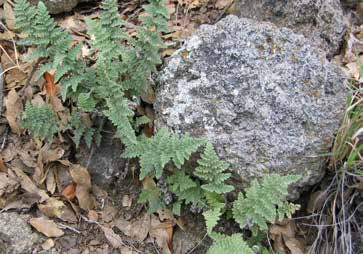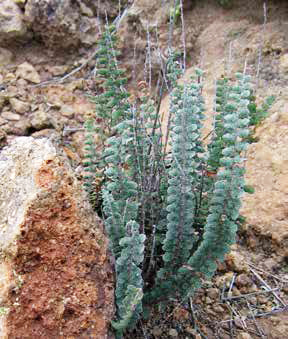In the Trans-Pecos region, ferns and their allies either flourish or become dormant in response to limited available moisture. When conditions are dry, many of the xeric (dry environment) ferns respond by curling up and going into a dormant stage. They revive and actively grow again when water becomes available.

Sharon C. Yarborough
At Fort Davis National Historic Site, there was a remarkable amount of moisture (both rain and snow) in the winter and spring of 2004. Almost 8" of precipitation accumulated from January through April. An inventory was conducted in response to this amount of moisture and the cool winter temperatures that together provided ideal growing conditions for fern populations. The lack of foliage on other vegetation during the winter period made the ferns easy to locate. By the end of the study period in early April, fern populations were all healthy; most were actively growing and sending up abundant new fronds.
Fern Taxa
SELAGINELLACEAE—Spikemoss Family
Selaginella peruviana - Peruvian Spikemoss
Selaginells mutica - Blunt Spikemoss
PTERlDACEAE—Maidenhair Fern Family
Astrolepis cochisensis - Jimmyfern, Cochise Scaly Cloak Fern
Astrolepis integerrima - Wholeleaf Cloak Fern, Hybrid Cloak Fern
Astrolepis sinuata - Wavyleaf Cloak Fern
Astrolepis windhamii - Windham Cloak Fern
Bommeria hispida - Dancing Bommeria, Hairy Bommer, Copper Fern
Cheilanthes bonariensis - Bonaire Lip Fern, Golden Lip Fern
Cheilanthes eatonii - Eaton Lip Fern
Cheilanthes eatonii forma castanea - Castanea Lip Fern
Cheilanthes feei - Slender Lip Fern
Cheilanthes Iindheimeri - Fairy Swords, Whitefoot Lip Fern
Cheilanthes tomentosa - Woolly Lip Fern
Cheilanthes villosa - Villous Lip Fern
Cheilanthes wrightii - Wright Lip Fern
Notholaena standleyi - Star Cloak Fern, Standley Cloak Fern
Pellaea atropurpurea - Purple Cliff Brake
Pellaea intermedia - Creeping Cliff Brake, Intermediate Cliff Brake
Pellaea wrightiana - Wright Cliff Brake
ASPLENIACEAE—Spleenwort Family
Asplenium resiliens - Little Ebony Spleenwort
DRYOPTERlDACEAE—Wood Fern Family
Phanerophlebia auriculata - Eared Holly Fern
Woodsia neomexicana - New Mexico Cliff Fern
POLYPODIACEAE—Polypody Family
Pleopeitis riograndensis - Rio Grande Scaly Polypody
Inventory
In 2004, 12 trips were made to fern habitats to resample fern populations that were previously inventoried in 2002 when 16 fern taxa were documented. All fern identifications were reconfirmed in 2004 and new areas with promising fern habitat were visited, resulting in seven new fern taxa identified. The total number of fern taxa documented in the park with this inventory is 23. The excellent condition of all fern populations during the 2004 study period allowed for some limited collecting of specimens.
Identification of Fern Taxa
All fern specimens were identified by Sharon C. Yarborough, author of “Ferns and Fern Allies of the Trans-Pecos and Adjacent Areas” and Assistant Curator of the Michael A. Powell Herbarium at Sul Ross State University, Alpine, Texas.
Voucher Specimens
Mounted herbarium specimen sheets of all 23 species have been made, and provided to the park. Duplicate specimens reside at the Michael A. Powell Herbarium.
Conclusions
The diverse and abundant fern flora of Fort Davis National Historic Site is a valuable natural resource which should continue to be monitored and protected. The many and varied fern habitats within the park foster the growth of a large number of Trans-Pecos ferns and fern allies, including both xeric and mesic (moist environment) species. The more moisture-loving fern species were primarily found in a newer addition to the park, a portion of Sleeping Lion Mountain. The ferns that occur at these sites should be monitored for continued population health and protection. There still may be additional species of fern and fern allies yet to be discovered, growing in the park’s unique habitats.

Sharon C. Yarborough
These interesting plants are a unique resource that can engage visitors at the park. Most of the fern species on the park’s list can easily be seen, identified, and enjoyed without leaving established trails.
Originally prepared by the Chihuahuan Desert Network Inventory and Monitoring Program in 2013. Updated in 2016.
Last updated: November 29, 2016
